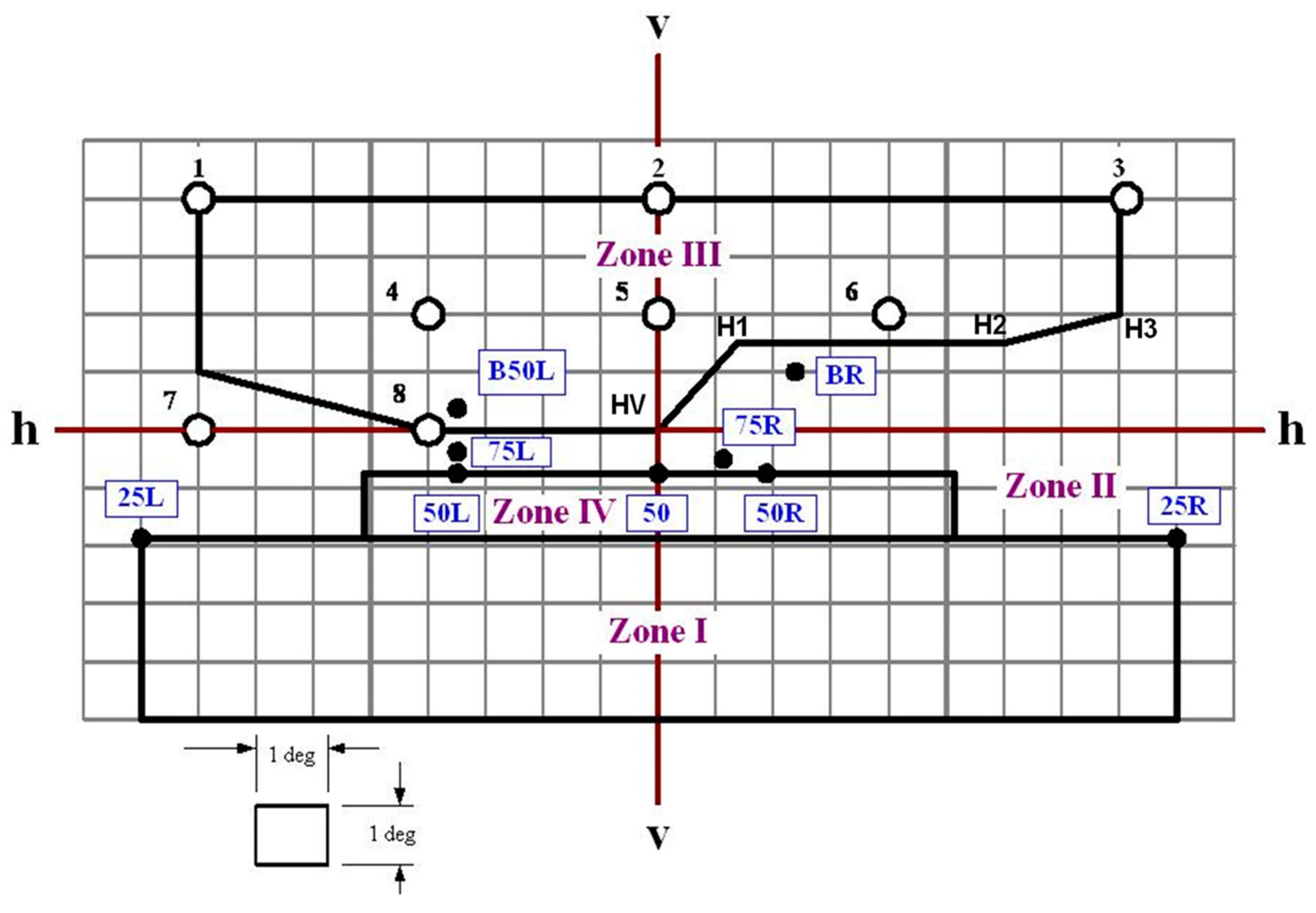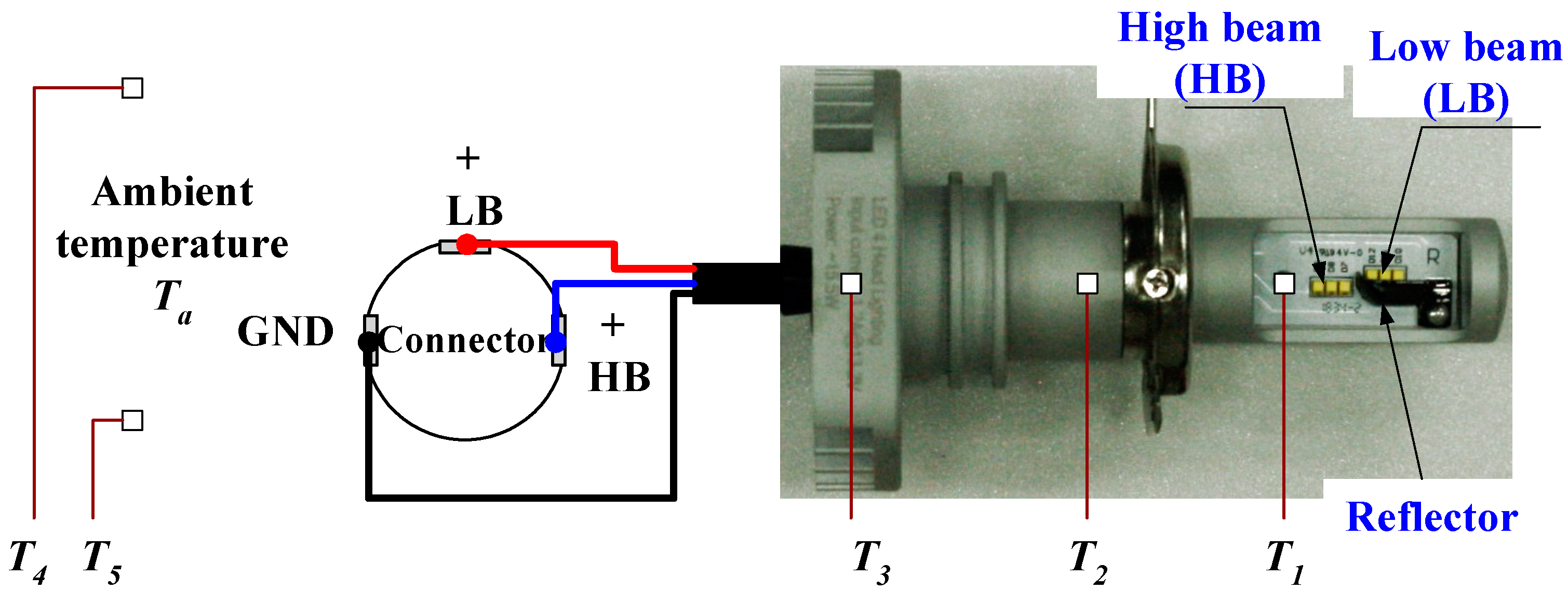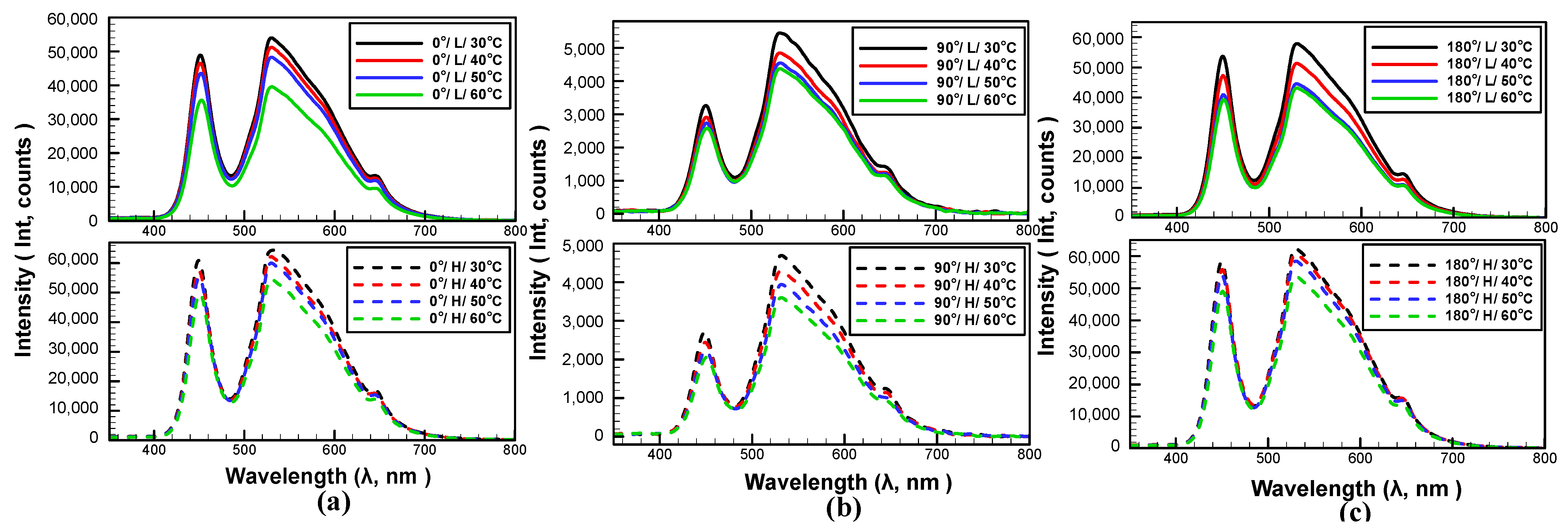Influence of Ambient Temperature on Optical Characteristics and Power Consumption of LED Lamp for Automotive Headlamp
Abstract
1. Introduction
2. Lighting Specification for Automotive Headlamps
3. Experimental Design and Implementation
4. Results and Discussion
5. Conclusions
Author Contributions
Funding
Institutional Review Board Statement
Informed Consent Statement
Data Availability Statement
Conflicts of Interest
References
- ICECAT, Philips Car Headlight Bulb, H4 Datasheet. 2018. Available online: https://objects.icecat.biz/objects/mmo_56674787_1575761387_8657_14018.pdf (accessed on 1 September 2022).
- Denton, T. Automobile Electrical and Electronic Systems, 4th ed.; Routledge: London, UK, 2013. [Google Scholar]
- Audi Website, Audi Matrix LED Headlights, Self-Study Program 619. Available online: https://procarmanuals.com/vag-ssp-619-audi-matrix-led-headlights (accessed on 1 September 2022).
- Headlamps in the New Mercedes-Benz E-Class: MULTIBEAM LED. Available online: https://youtu.be/0OJjvYPV3oc (accessed on 1 September 2022).
- BMW Website. Available online: https://www.bmw.com.bn/en/topics/offers-and-services/accessories-pages/bmw-accessory-showroom.bmw-adaptive-led-headlights.html (accessed on 1 September 2022).
- Ma, S.H.; Lee, C.H.; Yang, C.H. Achromatic LED-based projection lens design for automobile headlamp. Optik 2019, 191, 89–99. [Google Scholar] [CrossRef]
- Zhu, Z.; Wei, S.; Liu, R.; Hong, Z.; Zheng, Z.; Fan, Z.; Ma, D. Freeform surface design for high-efficient LED low-beam headlamp lens. Opt. Commun. 2020, 477, 126269. [Google Scholar] [CrossRef]
- Nair, G.B.; Dhoble, S.J. A perspective perception on the applications of light-emitting diodes. Luminescence 2015, 30, 1167–1175. [Google Scholar] [CrossRef]
- Luce, T. LED headlamps: The spiny path to a legal headlamp. In Proceedings of the European Workshop on Photonics in the Automobile, Geneva, Switzerland, 29 November 2004. [Google Scholar] [CrossRef]
- Yao, Q.; Hu, P.; Sun, P.; Liu, M.; Dong, R.; Chao, K.; Liu, Y. Laser-driven solid-state light sources. Adv. Mater. 2020, 32, 1907888. [Google Scholar] [CrossRef] [PubMed]
- Narendran, N.; Gu, Y.; Jayasinghe, L.; Freyssinier, J.P.; Zhu, Y. Long-term performance of white LEDs and systems. In Proceeding of First International Conference on White LEDs and Solid State Lighting, Tokyo, Japan, 26–30 November, 2007; pp. 174–179. [Google Scholar]
- Senawiratne, J.; Chatterjee, A.; Detchprohm, T.; Zhao, W.; Li, Y.; Zhu, M.; Xia, Y.; Li, X.; Plawsky, J.; Wetzel, C. Junction temperature, spectral shift, and efficiency in GaInN-based blue and green light emitting diodes. Thin Solid Film. 2010, 518, 1732–1736. [Google Scholar] [CrossRef]
- Wang, J.; Cai, Y.X.; Li, X.H.; Zhao, X.J.; Zhang, C. Design of automotive headlamp with high-power LEDS. Int. J. Automot. Technol. 2014, 15, 673–681. [Google Scholar] [CrossRef]
- Osram Ostar Headlamp, Datasheet Version 1.2. Available online: https://www.digikey.com/en/products/detail/osram-opto-semiconductors-inc/LE-UW-D1W3-01-5P7P-JM-T01-VAR/10423891 (accessed on 1 September 2002).
- Raypah, M.E.; Devarajan, M.; Sulaiman, F. Influence of injection current and ambient temperature on intensity and wavelength of low-power SMD LED. In Proceedings of the 2016 IEEE 37th International Electronics Manufacturing Technology (IEMT) & 18th Electronics Materials and Packaging (EMAP) Conference, Georgetown, Malaysia, 20–22 September 2016; pp. 1–6. [Google Scholar]
- Sökmen, K.F.; Yürüklü, E.; Yamankaradeniz, N. Computational thermal analysis of cylindrical fin design parameters and a new methodology for defining fin structure in LED automobile headlamp cooling applications. Appl. Therm. Eng. 2016, 94, 534–542. [Google Scholar] [CrossRef]
- Xi, Y.; Schubert, E.F. Junction-temperature measurement in GaN ultraviolet light-emitting diodes using diode forward voltage method. Appl. Phys. Lett. 2004, 85, 2163–2165. [Google Scholar] [CrossRef]
- Canale, L.; Dupuis, P.; Leng, S.; Zissis, G. Study of high-brightness led samples aged under stress temperature conditions: Electrical characterizations and signature evolution analysis. IEEE Trans. Ind. Appl. 2016, 52, 502–510. [Google Scholar] [CrossRef]
- Jung, E.D.; Lee, Y.L. Development of a heat dissipating LED headlamp with silicone lens to replace halogen bulbs in used cars. Appl. Therm. Eng. 2015, 86, 143–150. [Google Scholar] [CrossRef]
- Abdelmlek, K.B.; Araoud, Z.; Canale, L.; Charrada, K.; Zissis, G. Optimal substrate design for thermal management of high power multi-chip LEDs module. Optik 2021, 242, 167179. [Google Scholar] [CrossRef]
- Abdelmlek, K.B.; Araoud, Z.; Canale, L.; Nejma, F.B.; Charrada, K.; Zissis, G. Thermal management of LEDs packages within inclined enclosures for lighting applications. In Proceedings of the 2021 IEEE Industry Applications Society Annual Meeting (IAS), Vancouver, BC, Canada, 10–14 October 2021; pp. 1–6. [Google Scholar]
- Chen, S.; Chen, K.; Li, Z.; Tang, Y.; Zhuang, B.; Zhong, G.; Liang, G. Experimental investigation on the thermal performance of a light emitting diode headlamp with a flexible woven heat sink. Appl. Therm. Eng. 2017, 127, 1215–1222. [Google Scholar] [CrossRef]
- Lu, Z.; Bai, P.; Huang, B.; Henzen, A.; Coehoorn, R.; Liao, H.; Zhou, G. Experimental investigation on the thermal performance of three-dimensional vapor chamber for LED automotive headlamps. Appl. Therm. Eng. 2019, 157, 113478. [Google Scholar] [CrossRef]
- Singh, R.; Mochizuki, M.; Yamada, T.; Nguyen, T. Cooling of LED headlamp in automotive by heat pipes. Appl. Therm. Eng. 2020, 166, 114733. [Google Scholar] [CrossRef]
- Sivak, M.; Schoettle, B.; Flannagan, M. LED headlamps: Glare and colour rendering. Light. Res. Technol. 2004, 36, 295–303. [Google Scholar] [CrossRef]
- Lee, H.S.; Park, H.J.; Kwak, J.S. Improvement of disturbing color effects depending on the axial color of an automotive headlamp lens. Appl. Opt. 2017, 56, 5106–5111. [Google Scholar] [CrossRef]
- Khandekar, S.; Sahu, G.; Muralidhar, K.; Gatapova, E.Y.; Kabov, O.A.; Hu, R.; Luo, X.; Zhao, L. Cooling of high-power LEDs by liquid sprays: Challenges and prospects. Appl. Therm. Eng. 2021, 184, 115640. [Google Scholar] [CrossRef]
- Wu, Q.; Liang, C.; Huang, L. Thermal design and simulation of LEDs automotive headlamps. In Proceedings of the 21st International Conference on Electronic Packaging Technology (ICEPT), Guangzhou, China, 12–15 August 2020. [Google Scholar]
- ECE. ECE R112 Revision 3; United Nations Economic Commission for Europe: Geneva, Switzerland, 2013. [Google Scholar]
- Long, X.; He, J.; Zhou, J.; Fang, L.; Zhou, X.; Ren, F.; Xu, T. A review on light-emitting diode based automotive headlamps. Renew. Sust. Energ. Rev. 2015, 41, 29–41. [Google Scholar] [CrossRef]
- Wu, H.; Zhang, X.; Ge, P. Modular design of a high-efficiency LED headlamp system based on freeform reflectors. Opt. Laser Technol. 2015, 72, 79–85. [Google Scholar] [CrossRef]
- Supronowicz, R.; Fan, J.; Listowski, M.; Watras, A.; Fryc, I. Application of different metrics for describing light color quality of white LED. Photonics Lett. Pol. 2021, 13, 31–33. [Google Scholar] [CrossRef]
- Kim, W.; Kim, T.; Kim, S.; Yoon, S.; Jeong, H.; Song, J.; Seong, T. Improved angular color uniformity and hydrothermal reliability of phosphor-converted white light-emitting diodes by using phosphor sedimentation. Opt. Express 2018, 26, 28634–28640. [Google Scholar] [CrossRef]
- Raypah Muna, E.; Mutharasu, D.; Fauziah, S. Evaluation of current and temperature effects on optical performance of InGaAlP thin-film SMD LED mounted on different substrate packages. Chin. Phys. B 2017, 26, 078503. [Google Scholar] [CrossRef]
- Rad, S.D.; Islam, A.; Alnasser, A. Development of metal–graphene-filled hybrid composites: Characterization of mechanical, thermal, and electrical properties. J. Compos. Mater. 2018, 53, 3363–3376. [Google Scholar] [CrossRef]
- Lee, S.; Suh, D.; Kim, W.; Xu, C.; Kim, T.; Song, C.; Yoo, C.; Kim, Y.; Kim, J.; Baik, S. Carbon nanotube covalent bonding mediates extraordinary electron and phonon transports in soft epoxy matrix interface materials. Carbon 2020, 157, 12–21. [Google Scholar] [CrossRef]
- Yang, C.R.; Chen, C.D.; Cheng, C.; Shi, W.H.; Chen, P.H.; Teng, T.P. Thermal conductivity enhancement of AlN/PDMS composites using atmospheric plasma modification techniques. Int. J. Therm. Sci. 2020, 155, 106431. [Google Scholar] [CrossRef]
- Suresh, V.; Jegan, A.; Mohan, R.; Mahendran, A.; Gokulanathan, L. Experimental study of heat transfer rate in a stainless steel heating element using nano coating. Mater. Today Proc. 2021, 37, 3743–3746. [Google Scholar] [CrossRef]
- Bahru, R.; Zamri, M.F.M.A.; Shamsuddin, A.H.; Shaari, N.; Mohamed, M.A. A review of thermal interface material fabrication method toward enhancing heat dissipation. Int. J. Energy Res. 2021, 45, 3548–3568. [Google Scholar] [CrossRef]
- Ng, E.C.J.; Kueh, T.C.; Wang, X.; Soh, A.K.; Hung, Y.M. Anomalously enhanced thermal performance of carbon-nanotubes coated micro heat pipes. Energy 2021, 214, 118909. [Google Scholar] [CrossRef]
- Hadi, M.; Ismael, M.A.; Alhattab, H.A. Experimental investigation of thermal performance of the graphene-coated Al heat sink. Mater. Today: Proc. 2021, 42, 2779–2784. [Google Scholar] [CrossRef]
- Ghasemiasl, R.; Taheri, M.A.; Molana, M.; Raoufi, N. Experimental investigation of thermal performance of the graphene oxide coated plates. Heat Transfer–Asian Res. 2020, 49, 519–532. [Google Scholar] [CrossRef]





| Headlamps for RH Traffic | Class A Headlamp | Class B Headlamp | |||
|---|---|---|---|---|---|
| Test Point Designation | Test Point Angular Coordinates—Degrees | Required LUMINOUS Intensity cd | Required Luminous Intensity cd | ||
| Max | Min | Max | Min | ||
| Point B50L | 0.57U, 3.43L | 350 | 350 | ||
| BR | 1.0U, 2.5R | 1750 | 1750 | ||
| Point 75R | 0.57D, 1.15R | 5100 | 10,100 | ||
| Point 75L | 0.57D,3.43L | 10,600 | 10,600 | ||
| Point 50L | 0.86D, 3.43L | 13,200 | 13,200 | ||
| Point 50R | 0.86D, 1.72R | 5100 | 10,100 | ||
| Point 50V | 0.86D, 0 | 5100 | |||
| Point 25L | 1.72D, 9.0L | 1250 | 1700 | ||
| Point 25R | 1.72D, 9.0R | 1259 | 1700 | ||
| Any point in zone III | 625 | 625 | |||
| Any point in zone IV | 1700 | 2500 | |||
| Any point in zone I | 17,600 | <2I * | |||
| Deg. (°) | Ta (°C) | Low Beam | High Beam | ||||||
|---|---|---|---|---|---|---|---|---|---|
| CCT | CIE 1931 xy | CCT | CIE 1931 xy | ||||||
| K | Duv | CIE x | CIE y | K | Duv | CIE x | CIE y | ||
| 0 | 30 | 5949 | 0.0319 | 0.3191 | 0.3981 | 5835 | 0.0304 | 0.3225 | 0.3978 |
| 40 | 5963 | 0.0321 | 0.3187 | 0.3981 | 5854 | 0.0309 | 0.3219 | 0.3983 | |
| 50 | 5981 | 0.0324 | 0.3181 | 0.3981 | 5860 | 0.0309 | 0.3217 | 0.3983 | |
| 60 | 6005 | 0.0325 | 0.3174 | 0.3978 | 5875 | 0.0312 | 0.3213 | 0.3985 | |
| 90 | 30 | 5284 | 0.0389 | 0.3415 | 0.4379 | 5211 | 0.0398 | 0.3447 | 0.4433 |
| 40 | 5315 | 0.0392 | 0.3403 | 0.4375 | 5203 | 0.0397 | 0.3450 | 0.4433 | |
| 50 | 5306 | 0.0398 | 0.3407 | 0.4376 | 5219 | 0.0398 | 0.3443 | 0.4429 | |
| 60 | 5311 | 0.0388 | 0.3404 | 0.4367 | 5234 | 0.0396 | 0.3437 | 0.4416 | |
| 180 | 30 | 5881 | 0.0312 | 0.3211 | 0.3983 | 5843 | 0.0307 | 0.3223 | 0.3984 |
| 40 | 5899 | 0.0316 | 0.3205 | 0.3986 | 5840 | 0.0309 | 0.3223 | 0.3989 | |
| 50 | 5926 | 0.0316 | 0.3198 | 0.3981 | 5850 | 0.0310 | 0.3220 | 0.3988 | |
| 60 | 5922 | 0.0317 | 0.3199 | 0.3983 | 5867 | 0.0312 | 0.3215 | 0.3988 | |
| Deg. (°) | Ta (°C) | Low Beam | High Beam | ||||||||||
|---|---|---|---|---|---|---|---|---|---|---|---|---|---|
| Illuminance | Power Consumption | LEF | Illuminance | Power Consumption | LEF | ||||||||
| lx | PD% | W | PD% | lx/W | PD% | lx | PD% | W | PD% | lx/W | PD% | ||
| 0 | 30 | 2795.0 | — | 13.71 | — | 203.8 | — | 3226.7 | — | 14.30 | — | 225.6 | — |
| 40 | 2695.0 | −3.6 | 12.72 | −7.2 | 211.8 | 3.9 | 2961.7 | −8.2 | 13.20 | −7.7 | 224.4 | −0.5 | |
| 50 | 2511.7 | −10.1 | 11.59 | −15.5 | 216.8 | 6.4 | 2566.7 | −20.5 | 12.12 | −15.2 | 211.7 | −6.2 | |
| 60 | 2356.7 | −15.7 | 10.74 | −21.7 | 219.5 | 7.7 | 2448.3 | −24.1 | 11.09 | −22.5 | 220.8 | −2.1 | |
| 90 | 30 | 276.3 | — | 13.65 | — | 20.2 | — | 215.0 | — | 14.39 | — | 14.9 | — |
| 40 | 265.7 | −3.9 | 12.66 | −7.3 | 21.0 | 3.7 | 197.5 | −8.1 | 13.13 | −8.8 | 15.0 | 0.7 | |
| 50 | 240.2 | −13.1 | 11.68 | −14.4 | 20.6 | 1.6 | 184.2 | −14.3 | 12.06 | −16.2 | 15.3 | 2.2 | |
| 60 | 235.2 | −14.9 | 10.76 | −21.2 | 21.9 | 8.0 | 171.8 | −20.1 | 11.15 | −22.5 | 15.4 | 3.2 | |
| 180 | 30 | 2318.3 | — | 13.65 | — | 169.9 | — | 2980.0 | — | 14.18 | — | 210.2 | — |
| 40 | 2101.7 | −9.3 | 12.69 | −7.0 | 165.6 | −2.5 | 2843.3 | −4.6 | 13.01 | −8.2 | 218.5 | 4.0 | |
| 50 | 2001.7 | −13.7 | 11.64 | −14.7 | 172.0 | 1.2 | 2656.7 | −10.9 | 12.12 | −14.5 | 219.2 | 4.3 | |
| 60 | 1873.3 | −19.2 | 10.73 | −21.3 | 174.5 | 2.7 | 2355.0 | −21.0 | 11.11 | −21.6 | 212.0 | 0.9 | |
| Deg. (°) | Ta* (°C) | Low Beam | High Beam | ||||||||||||||||||
|---|---|---|---|---|---|---|---|---|---|---|---|---|---|---|---|---|---|---|---|---|---|
| T1 (°C) | T2 (°C) | T3 (°C) | Ta** (°C) | PDT1 (%) | PDT2 (%) | PDT3 (%) | T1–T2 (°C) | T2–T3 (°C) | T3–Ta (°C) | T1 (°C) | T2 (°C) | T3 (°C) | Ta** (°C) | PDT1 (%) | PDT2 (%) | PDT3 (%) | T1–T2 (°C) | T2–T3 (°C) | T3–Ta (°C) | ||
| 0 | 30 | 78.8 | 66.3 | 58.3 | 31.0 | — | — | — | 12.5 | 8.0 | 27.3 | 75.9 | 63.8 | 56.4 | 31.2 | — | — | — | 12.1 | 7.4 | 25.2 |
| 40 | 84.7 | 73.2 | 65.9 | 42.3 | 7.5 | 10.4 | 12.9 | 11.5 | 7.3 | 23.6 | 82.0 | 71.1 | 64.3 | 41.8 | 8.1 | 11.4 | 13.9 | 11.0 | 6.8 | 22.5 | |
| 50 | 91.2 | 80.9 | 74.3 | 51.9 | 15.7 | 22.0 | 27.4 | 10.3 | 6.6 | 22.4 | 88.3 | 78.2 | 72.1 | 50.7 | 16.3 | 22.7 | 27.9 | 10.0 | 6.1 | 21.4 | |
| 60 | 96.4 | 87.1 | 81.1 | 61.5 | 22.4 | 31.3 | 39.1 | 9.4 | 5.9 | 19.7 | 94.2 | 85.3 | 79.8 | 60.6 | 24.1 | 33.7 | 41.4 | 8.9 | 5.5 | 19.2 | |
| 90 | 30 | 78.3 | 66.0 | 58.2 | 31.5 | — | — | — | 12.3 | 7.8 | 26.7 | 73.9 | 61.5 | 54.2 | 30.7 | — | — | — | 12.4 | 7.3 | 23.5 |
| 40 | 84.0 | 72.8 | 65.7 | 41.3 | 7.3 | 10.2 | 12.9 | 11.2 | 7.1 | 24.4 | 81.5 | 70.7 | 64.2 | 41.5 | 10.2 | 15.0 | 18.4 | 10.8 | 6.6 | 22.7 | |
| 50 | 89.9 | 79.6 | 73.3 | 52.0 | 14.8 | 20.6 | 25.8 | 10.3 | 6.3 | 21.3 | 87.8 | 78.0 | 72.2 | 51.4 | 18.7 | 26.9 | 33.1 | 9.7 | 5.9 | 20.8 | |
| 60 | 95.9 | 86.5 | 80.8 | 61.2 | 22.4 | 31.0 | 38.8 | 9.4 | 5.7 | 19.6 | 93.5 | 84.5 | 79.3 | 60.6 | 26.4 | 37.4 | 46.2 | 8.9 | 5.3 | 18.7 | |
| 180 | 30 | 79.5 | 66.1 | 58.2 | 31.0 | — | — | — | 13.4 | 7.8 | 27.2 | 76.6 | 63.7 | 56.4 | 31.3 | — | — | — | 12.9 | 7.3 | 25.1 |
| 40 | 85.4 | 73.0 | 65.7 | 42.0 | 7.5 | 10.4 | 12.8 | 12.4 | 7.3 | 23.7 | 83.4 | 71.7 | 65.1 | 42.0 | 8.9 | 12.6 | 15.4 | 11.7 | 6.6 | 23.0 | |
| 50 | 91.7 | 80.5 | 73.9 | 52.3 | 15.5 | 21.7 | 26.8 | 11.3 | 6.6 | 21.6 | 89.0 | 78.3 | 72.1 | 52.0 | 16.2 | 22.9 | 28.0 | 10.8 | 6.1 | 20.2 | |
| 60 | 97.4 | 87.1 | 81.1 | 61.5 | 22.7 | 31.6 | 39.2 | 10.3 | 6.0 | 19.6 | 95.0 | 85.2 | 79.7 | 61.1 | 24.0 | 33.8 | 41.3 | 9.8 | 5.5 | 18.6 | |
Publisher’s Note: MDPI stays neutral with regard to jurisdictional claims in published maps and institutional affiliations. |
© 2022 by the authors. Licensee MDPI, Basel, Switzerland. This article is an open access article distributed under the terms and conditions of the Creative Commons Attribution (CC BY) license (https://creativecommons.org/licenses/by/4.0/).
Share and Cite
Chang, C.-H.; Teng, T.-P.; Teng, T.-C. Influence of Ambient Temperature on Optical Characteristics and Power Consumption of LED Lamp for Automotive Headlamp. Appl. Sci. 2022, 12, 11443. https://doi.org/10.3390/app122211443
Chang C-H, Teng T-P, Teng T-C. Influence of Ambient Temperature on Optical Characteristics and Power Consumption of LED Lamp for Automotive Headlamp. Applied Sciences. 2022; 12(22):11443. https://doi.org/10.3390/app122211443
Chicago/Turabian StyleChang, Chun-Hsin, Tun-Ping Teng, and Tun-Chien Teng. 2022. "Influence of Ambient Temperature on Optical Characteristics and Power Consumption of LED Lamp for Automotive Headlamp" Applied Sciences 12, no. 22: 11443. https://doi.org/10.3390/app122211443
APA StyleChang, C.-H., Teng, T.-P., & Teng, T.-C. (2022). Influence of Ambient Temperature on Optical Characteristics and Power Consumption of LED Lamp for Automotive Headlamp. Applied Sciences, 12(22), 11443. https://doi.org/10.3390/app122211443






